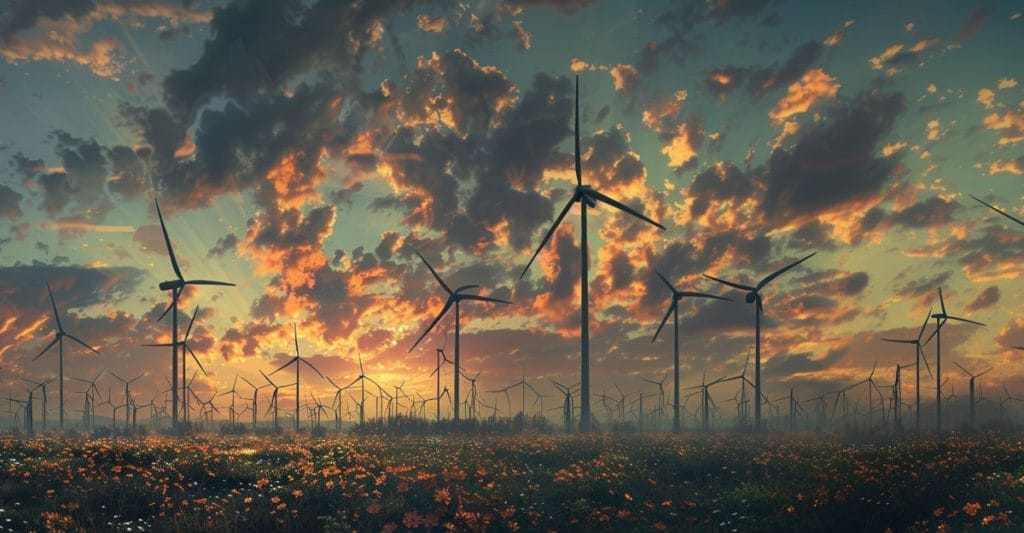The federal government recently approved the first west coast wind energy areas off the coast of Oregon to add to six along the east coast. Meantime, power generated by Texas wind farms, the largest power market in America, fell a huge chunk in January due to low wind speeds. Lisa Fletcher looks at the shifting winds amid the Biden administration’s ambitious plans to move toward this form of green energy.
The following is a transcript of a report from “Full Measure with Sharyl Attkisson.” Watch the video by clicking the link at the end of the page.
Delaware’s beautiful Atlantic shoreline has always drawn visitors to pristine beaches and abundant wildlife, but a recent arrival on the horizon has brought opportunity and controversy, and now the potential to unravel a key pillar of President Biden’s renewable energy plans.
Near the town of Lewes, the University of Delaware operates a single two-megawatt wind turbine as a test bed and power source, helping to train a new generation of renewable power engineers and researchers. But the big goal for this state and many others up and down the Atlantic coast is out there at sea.
The vision: to build hundreds of wind turbines from the Carolinas to New England to help power America’s future.
If they get that built, they would also go a long way to meeting the White House’s goal of generating 30,000 megawatts of offshore wind power by 2030, enough to power 10 million homes.
Two years ago, we were in Martha’s Vineyard, the promised site of the newest commercial-scale offshore wind project, called Vineyard Wind. It started producing power in January. By the end of this year, five turbines are scheduled to be turning.
So, a year ago, it looked like the industry had the wind at its back, with projects underway or planned up and down the coast. But then in August, the giant Danish energy company, Orsted, canceled two projects off New Jersey. The company saying “high inflation, rising interest rates, and supply chain problems” had doomed their 2,200-megawatt plans.
For one congressman from Maryland, that economic bombshell was a breath of fresh air.
Lisa: When you first heard that two big offshore wind projects were being canceled in New Jersey, what did you think?
Rep. Andy Harris: Well, I thought finally people had seen the light that people were rising up and raising objections to this really costly, just uncalled-for way to produce energy. Finally, people are paying attention, and these companies, I think, realize that these roads are long and hard.
Andy Harris is a Republican representing Maryland’s first congressional district that covers part of the state’s coast. He’s a vocal opponent of offshore wind.
Rep. Harris: It’s just not ready for primetime. Now, maybe ten years from now, it becomes economically more feasible. Great, let’s revisit it. But right now, onshore wind, it’s fine. It’s economically viable. Offshore wind is not.
There are politicians up and down the coast now questioning offshore wind’s economic and environmental credentials, and scientists have raised concerns about what the turbines could do to marine habitats vital for whales, while fishermen worry the towers could displace their catch.
The Biden Administration and Congress have pumped tens of millions of dollars into subsidies to boost the offshore industry but are now facing accusations that in their rush to build, they failed to properly assess the risks and costs of offshore wind.
It’s those costs that really worry Rob Book; he’s the CEO of Delaware Electric Cooperative, serving more than 100,000 customers in the state.
Rob Book: I think we’ve got a way to go with respect to wind power off the shores of our coast here. In many cases, we’ve seen a lot of contracts come and recently go. Three states that are right close to us: New York, New Jersey, Maryland. They have all had their contracts pulled because, quite frankly, the numbers don’t work.
Lisa: You buy power, so you’re looking at things five, ten, maybe even 20 years out. How does that work? Can you translate for me what the working equation would look like for a wind facility.
Book: What we’re seeing with respect to our numbers and where we buy power, it’s kind of a differentiation of about two and a half times for us to buy power from an offshore wind project, versus where we buy power.
Lisa: Rob, why do you think it’s two and a half times more expensive?
Book: Well, it’s not a cheap proposition. Let me make it very clear. We are very interested in renewable resources for our power supplies, but the numbers have to work.
But getting the “numbers to work” has become increasingly difficult, amid high-interest rates and inflation, not to mention the fact the U.S. lacks the factories and ships needed to rapidly build and install offshore all the wind projects planned.
Back in Delaware, plans for developing an offshore wind farm are moving forward, but slowly, as even with federal tax credits, the costs are high for a small state.
We asked the governor, Democrat John Carney, for comment. He didn’t respond, nor did Lisa Blunt Rochester, the state’s sole congresswoman.
But local retiree and activist Peggy Schultz is delighted to talk up the benefits of offshore wind, even as many politicians are not.
Peggy Shultz: One 800-megawatt project would supply 28% of Delaware’s electricity. That’s big, one chunk of, you know, a 28% chunk. And it would be clean.
Schultz started a group bringing together local people and organizations like the Sierra Club to campaign in favor of offshore wind power.
Shultz: We have a global climate crisis. Maybe our one project in Delaware will not swing the pendulum toward safety for the earth, but it will help. We need all the pendulum-swinging we can get.
When it comes to public opinion, polling suggests views are changing in some states. A recent Monmouth University poll in New Jersey found support plunging from 76% to 54% in the last four years, and opposition to offshore power growing.
Declining public support — one of the reasons perhaps fewer political leaders are willing to publicly support new wind projects.
Lisa: I think politicians are hesitating to talk about this issue right now. Have you gotten that sense?
Schultz: Yes, yes, it seems that they are, and of course, that’s not my favorite kind of politician. I like it when people come out and say what they believe and stick by it. But they don’t want to get out on a limb that will be cut behind them, I guess.
For now, Delaware’s coastal waters remain undeveloped, as a new industry, and the people who have backed it, work out a way to survive these tough economic headwinds.
Sharyl (on-camera): So what exactly is so much more expensive about the offshore wind projects?
Lisa: Well, it’s largely because it’s a new industry, and the costs seem to grow every month. So, for example, a turbine could cost $3 to 5 million, but the bigger number is in building the platforms. We talked to Dominion Energy of Virginia. They contracted to build a ship to install the platforms — $625 million. The cost to rent one — $220,000 a day. Plus, the maintenance on each of these turbines can be about $45,000 a year.
Watch video here.

Visit The Sharyl Attkisson Store today
Unique gifts for independent thinkers
Proceeds benefit independent journalism




Let see how easy it will be to find reports of dead whales and birds
Andrew Metrick,
Wind Farms Can’t Stop
What this Scribbler
Terms :
“Cyclical Solar Effected Climate Change”
( Google : “Precession of the Equinoxes” ).
The rest of the story :
Scroll down to quotes from this book :
“A N G E L S don’t PLAY this HAARP, “
found in here :
https://sharylattkisson.com/2023/04/washington-dc-ranked-most-innovative-in-us/#comment-163760
-Rick